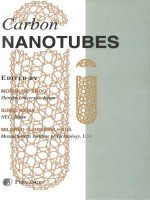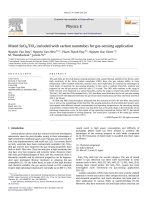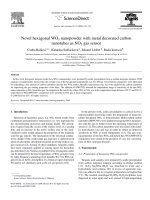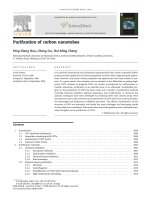Carbon Nanotubes (CNTs)
Bạn đang xem bản rút gọn của tài liệu. Xem và tải ngay bản đầy đủ của tài liệu tại đây (1.7 MB, 42 trang )
Class: Material Science Engineering
Student : Hoang Van
Hanoi
Tien -2012
DID YOU KNOW?
Carbon nanotubes, composed of interlocking
carbon atoms, are 1000x thinner than an
average human hair – but can be 200x
stronger than steel.
outline
Definition
Theory and properties
Synthesis
Potential and current applications
Challenges and future
What are carbon nanotubes
CNT: Rolling-up a graphene sheet to form a tube
Schematic
of a CNT
STM image
of CNT
4
Carbon nanotubes are hexagonally shaped
arrangements of carbon atoms that have
been rolled into tubes.
These tiny straw-like cylinders of pure carbon
have useful electrical propeties. They have
already been used to make tiny transistor and
one-dimentional copper wire
Types of CNTs
Single Wall CNT (SWCNT)
Multiple Wall CNT (MWCNT)
Can be metallic or semiconducting
depending on their geometry.
Single- walled
-Most single-walled
nanotubes (SWNTs)
have a diameter of cloes
to 1 nanometer,with a
tube length that can be
many millions of time
longer
-The structure of a
SWNTs can be
conceptualized by
wrapping a one-atomthick layer of graphite
called graphene in to a
seamless cylender
If:
m=0 , the nanotubes are called zigzag
n=m ,the nanotubes are called armchair
Otherwise ,they are called chiral
Multi-walled
Multi-walled nanotubes (MWNTs) consist of
multiple rolled layer( concentric tubes) of
graphene
Triple-walled
armchair CNTs
In the Russian Doll model, sheets of graphite are
arranged in concentric cylinders, e.g., a (0,8) singlewalled nanotube (SWNT) within a larger (0,17) singlewalled nanotube.
In the Parchment model, a single sheet of graphite is
rolled in around itself, resembling a scroll of parchment
or a rolled newspaper.
The interlayer distance in multi-walled nanotubes is
close to the distance between graphene layers in
graphite, approximately 3.4 Å. The Russian Doll structure
is observed more commonly. Its individual shells can be
described as SWNTs, which can be metallic or
semiconducting.
compare
Single –walled CNTs exhibit electric
properties that are not shared by the multiwalled CNTs variant
SWNTs is useful in the development of the
first intramolecular field effect transistors
(FET)
torus
-Torus is theoretically described
as carbon nanotube bent into a
torus (doughnut shape) .
-Nanotorus are predicted to
have many unique properties
such as :
+magnetic moments
+thermal stability …
-Vary widely depending on
radius of the torus and the
radius of the tube
nanobud
In nanotechnology,carbon nanobuds form a
material (discovered and synthesized in 2006)
which combines two previously discovered
allotropes of carbon: carbon nanotubes and
spheroidal fullerences (or, in short, fullerenes)
fullerenes are covalently bonded to the outer
sidewalls of the underlying nanotube
=>>>> Has useful properties of both fullerenes and
carbon nanotubes
Extreme carbon nanotubes
-The observation of the longest carbon
nanotubes (18.5 cm long) was reported in
2009. These nanotubes were grown on
Si substrates using an improved chemical
vapor deposition (CVD) method and
represent electrically uniform arrays of
single-walled carbon nanotubes.
-The shortest carbon nanotube is the
organic compound cycloparaphenylene
-The thinnest carbon nanotube is
armchair (2,2) CNT with a diameter of 3
Å. This nanotube was grown inside a
multi-walled carbon nanotube
-The thinnest freestanding single-walled
carbon nanotube is about 4.3 Å in
diameter
PROPERTIES OF
CARBON
NANOTUBES
Strength and elasticity
CNTs are expected to be the
ultimate high-strength filber
Single wall carbon nanotubes
are stiffer than steel and are
very resistant to damage
from physical forces
Carbon Nanotubes (CNTs)
very useful as probe tips for
very high-resolution scanning
probe microscopy.
elasticity
-The current Young’s modulus value of single walled
carbon nanotubes is about 1 terapascal
-The modulus of the multi walled carbon nanotubes
correlates to the amount of disorder in the carbon
nanotube walls
-when multi walled carbon nanotubes break, the
outermost layers break first
Comparison of mechanical
properties
Materials
Young’modulus(Tpa)
Tensile
strength(Gpa)
Elongation at
break(%)
SWNTE
~1 (from 1 to 5)
13-53
16
Armchair
SWNTT
0.94
126.2
23.1
Zigzag SWNTT
0.94
94.5
15.6-17.5
Chiral SWNT
0.92
MWNTE
0.2-0.8-0.95
11-63-150
Stainless steelE
0.186-0.214
0.38-1.55
15-50
Kevlar-29&149E
0.06-0.18
3.6-3.8
~2
Experimental observation;
E
T
Theoretical prediction
Electrical properties
For a given (m,n)
nanotubes:
If n=m(armchair) the
CNTS is metalic
If n-m is multiple of 3
,the CNTs is
semiconducting with a
small band gap
Otherwise ,the CNTs is
moderates
semiconductor
Thermal property
All nanotubes are expected to be very good thermal
conductors along the tube, exhibiting a property known
as "ballistic conduction ", but good insulators laterally to
the tube axis.
SWNT has a room-temperature thermal conductivity
along its axis of about 3500 W·m−1·K−1.
in copper : 385 W·m−1·K−1
A SWNT has a room-temperature thermal conductivity
across its axis (in the radial direction) of about 1.52
W·m−1·K−1. (same as oil)
defect
As with any material, the existence of a
crystallographic defect affects the material
properties.
Because of the very small structure of CNTs, the
tensile strength of the tube is dependent on its
weakest segment in a similar manner to a chain,
where the strength of the weakest link becomes
the maximum strength of the chain.
Crystallographic defects also affect the tube's
electrical properties and thermal properties.
Toxicity .
Under some conditions ,nanotubes can cross
membrane barriers ,which suggests that if raw
materials reach the organs, they can include
harmful effects such as inflammatory and
fibrotic reactions
CNTs were capable of
producing
inflammation, epithelioid
granulomas (microscopic nodules), fibrosis, and
biochemical/toxicological changes in the lungs
=>>>carbon nanotubes can pose a serious risk to
human health
synthesis
Techniques have
been developed
to produce carbon
nanotubes in
sizeable quanlities
,some of them are:
- Arc discharge
- Laser ablation
- Chemical vapor
deposition(CVD)
Arc discharge
Nanotubes were observed in 1991 in the carbon
soot of graphite electrodes during an arc
discharge, by using a current of 100 amps , that
was intended to produce fullerenes.
the carbon contained in the negative electrode
sublimates because of the high-discharge
temperatures.
The yield for this method is up to 30% by weight
and it produces both single- and multi-walled
nanotubes with lengths of up to 50 micrometers
with few structural defects









